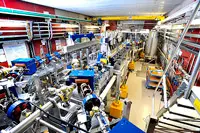Electronics News
Archive : 24 November 2014 год
 Scientists at the Helmholtz-Zentrum Dresden-Rossendorf (HZDR), in partnership with researchers from Berlin, France, the Czech Republic and the US, believe that graphene, when exposed to high magnetic fields, could enable a new type of laser.
Scientists at the Helmholtz-Zentrum Dresden-Rossendorf (HZDR), in partnership with researchers from Berlin, France, the Czech Republic and the US, believe that graphene, when exposed to high magnetic fields, could enable a new type of laser.
According to the team, it has been known for some years that the energy states of graphene in a magnetic field – known as Landau levels – are different to those of semiconductors. "Many fascinating effects have been discovered with graphene in magnetic fields, but the dynamics of electrons have never been studied in such a system until now," said HZDR physicist Dr Stephan Winnerl.
In their work, the team exposed graphene to a 4Tesla magnetic field and the results were said to have 'astonished' the researchers.
The strength of the magnetic field meant electrons could occupy only certain energy states, but these energy levels gradually emptied. The explanation was collisions between electrons. "This effect is known as Auger scattering, but no one expected it would be so strong and would cause an energy level to become depleted," Dr Winnerl continued.
This discovery could be used to develop a laser that can produce light with arbitrarily adjustable wavelengths in the infrared and terahertz ranges. "Such a Landau-level laser was long considered impossible," said Dr Winnerl. "But with graphene, this dream could become a reality."
Author
Graham Pitcher
Source: www.newelectronics.co.uk
 A New York based start up company has used an open source approach, as well as funding from Kickstarter, to develop AirBeam – a handheld sensor which determines the concentration of particles in the air measuring 2.5µm or less.
A New York based start up company has used an open source approach, as well as funding from Kickstarter, to develop AirBeam – a handheld sensor which determines the concentration of particles in the air measuring 2.5µm or less.
According to AirCasting, PM2.5 is one of the six air pollutants monitored and regulated by the US Environmental Protection Agency. It's also a figure of interest to the EU, which has set a requirement that PM2.5 concentrations should not exceed 25µg/m3.
The reason for the concern is that these particles – produced from sources such as diesel car exhausts – are small enough to pass through the lungs and enter the bloodstream, with adverse health effects.
AirBeam, developed with Sonoma Technology and New York University's School of Medicine, draws air into a sensing chamber, where light from an LED is scattered from the particles in the air. A detector then estimates the number of particles in the air.
This data is transmitted once per second via Bluetooth to the AirCasting app on an Android phone, where it is graphed in real time. Areas with higher PM2.5 concentration are shown in red.
At the end of each AirCasting session, the collected data is sent to the AirCasting website, where the data is used to generate maps showing where PM2.5 concentrations are highest.
The company also plans to develop LiteBeam. This hand held device, which is built around the PIC microcontroller based IOIO board, takes data from the AirCasting app via Bluetooth and illuminates green, yellow or red LEDs, according to the concentration.
The AirCasting app and website code is available on GitHub as open source, along with the AirBeam firmware and electronic schematics. The STL files for 3D printing the AirBeam and LiteBeam enclosures can be downloaded from www.shapeways.com.
For more information on open source sensor software, click here.
Author
Graham Pitcher
Source: www.newelectronics.co.uk
![]() A completely new form of silicon has been created which, according to its developers, holds promise for use in next generation solar cells, LEDs and other semiconductor technologies.
A completely new form of silicon has been created which, according to its developers, holds promise for use in next generation solar cells, LEDs and other semiconductor technologies.
Developed by a team of Carnegie scientists from the US, the silicon is a so-called allotrope, which means a different physical form of the same element, in the same way that diamonds and graphite are both forms of carbon.
Unlike the conventional diamond structure, the silicon allotrope consists of an open framework, called a zeolite-type structure, which is comprised of channels with five, six and eight membered silicon rings.
To create it, the researchers used a novel precursor process in which a compound of silicon and sodium, Na4Si24, was formed under high pressure conditions.
The compound was then recovered to ambient pressure, and the sodium was completely removed by heating under vacuum.
The resulting pure silicon allotrope, Si24, is said to have the ideal band gap for solar energy conversion technology, and can absorb, and potentially emit, light far more effectively than conventional diamond structured silicon.
What's more, it is stable at ambient pressure to at least 450°C.
Researcher Duck Young Kim said: "Advanced electronic structure theory and experiment have converged to deliver a real material with exciting prospects.
"We believe that high pressure research can be used to address current energy challenges, and we are now extending this work to different materials with equally exciting properties."
Author
Laura Hopperton
Source: www.newelectronics.co.uk

